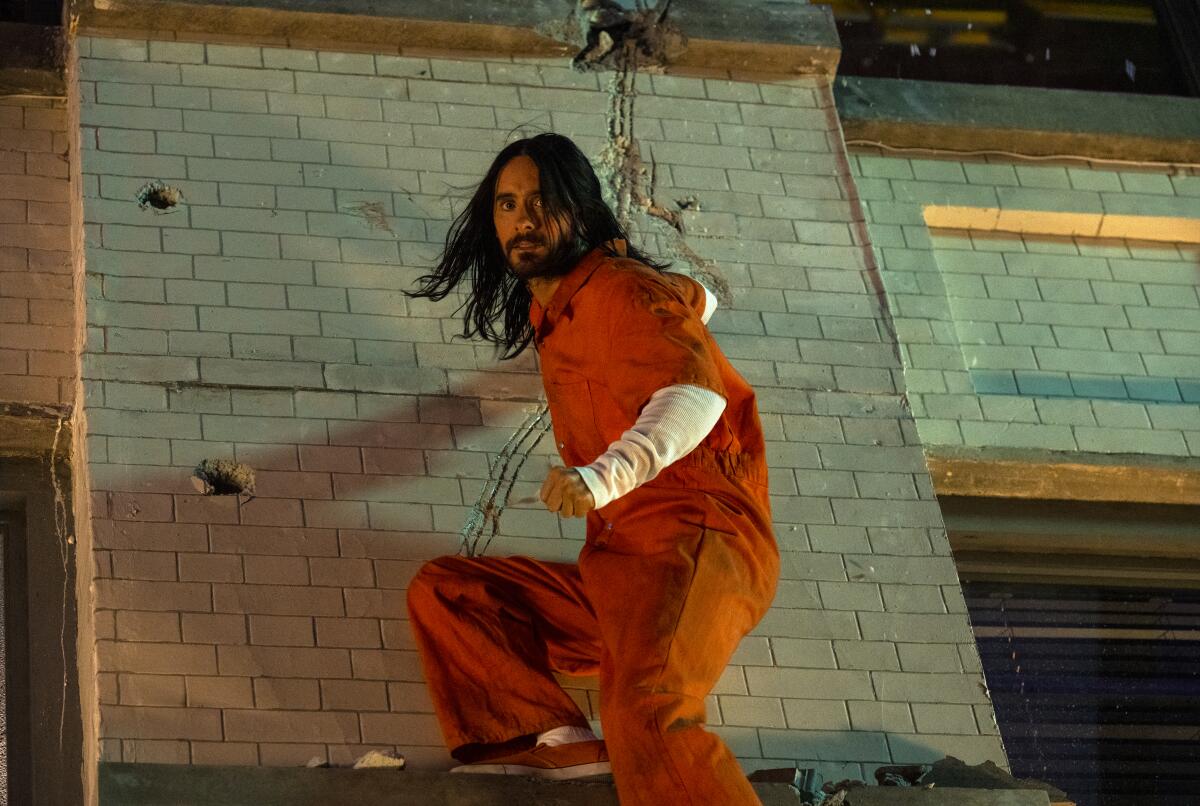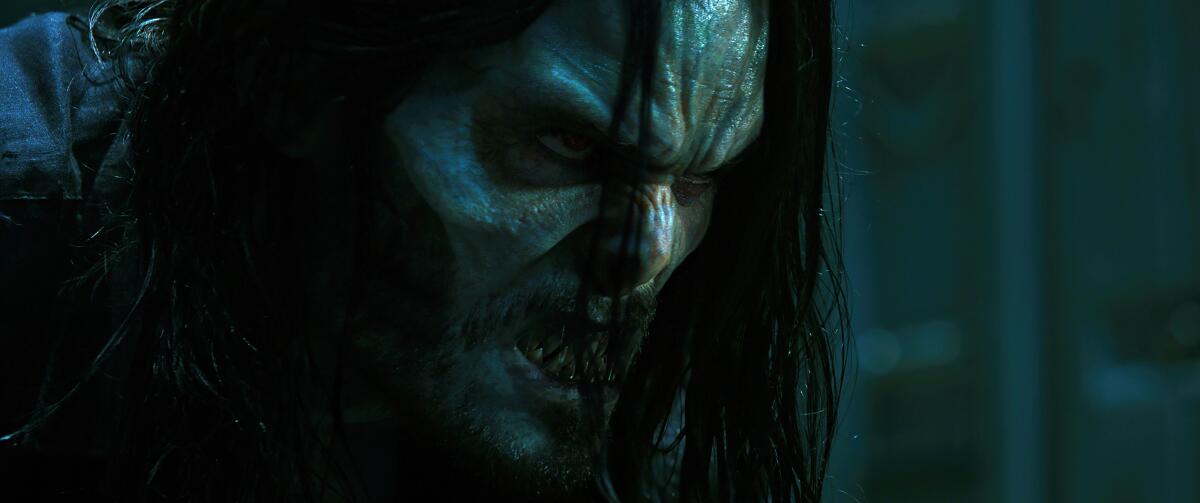Review: Marvel’s misbegotten ‘Morbius’ is a colossal snore

In “Morbius,” a helicopter sweeps through the foggy jungles of Costa Rica landing on a remote cliff. As the camera cranes through a murky CGI-drenched cave, you’d be hard pressed to feel the opening scene’s intended gloom. It’s no secret the desperate lengths contemporary movies, especially of the comic book variety, rely on VFX to do a film’s emotional heavy lifting. And following “Venom,” “Joker,” and so forth, the tired novelty of villains starring in their own sympathetic origin stories offers few surprises. So as Dr. Michael Morbius (Jared Leto), a brooding biochemist living with a blood disease, sways with the assistance of crutches getting off the helicopter, the mystery of his story is moot. We’ve seen this movie before, in far, far better forms.
Daniel Espinosa’s “Morbius,” a misbegotten, artistically bankrupt bid by writers Matt Sazama and Burk Sharpless to fuse a gothic horror edge to the MCU, is the nadir of comic book cinema. Created by Roy Thomas and Gil Kane, the titular villain, sometimes anti-hero, sprung from the pages of “The Amazing Spider-Man” in 1971, imbuing the webslinger’s universe with a supernatural grittiness. On its face, injecting Morbius into the sterile, all-too-clean confines of the MCU should accomplish similar aims. Espinosa, unfortunately, is so beholden to the timbre of mass entertainment, he struggles to provide his film with the necessary bloodlust, brutality and frights to rise above a snore.
For your safety
The Times is committed to reviewing theatrical film releases during the COVID-19 pandemic. Because moviegoing carries risks during this time, we remind readers to follow health and safety guidelines as outlined by the CDC and local health officials.
The scrubbing in “Morbius” starts with a flashback to 25 years earlier. A young Morbius befriends Milo, a boy similarly afflicted with a blood disease requiring three transfusions a day to live. They view themselves as two broken people defying a cruel world. It’s a cloying ableist angle, barely dealt with by the haphazard script, worsened when Dr. Nichols (a criminally unused Jared Harris), the head of the facility where they are being treated, notices Morbius’ innate gift for mechanics and sends him to a place where his talents will not be wasted.
Unlike other elongated comic book movies, Espinosa’s flick, clocking in at 108 minutes, features a compact run time. Bearing in mind the sage words of critic Roger Ebert, however, “No good movie is too long and no bad movie is short enough.” Morbius falls in the latter.
In the early going, for instance, the film goes to great lengths to build a romance between Morbius and the devoted Dr. Martine Bancroft (Adria Arjona). She steadfastly supports the pained and pale Morbius — now a Nobel Prize winner for inventing artificial blood — by assisting in his unethical experiments. Fusing together human and bat DNA, he eventually tests his invented serum on himself, accidentally morphing into a dhampir. Empowered with super strength, he no longer needs crutches to walk. He also gains sonic hearing, can float through the air and communicate with bats. The problem: Every few hours he needs blood or he’ll revert back to his past state.
We’re never wholly invested in Morbius. That shortcoming somewhat stems from Leto. The forlorn character serves as his second trip through comic book land, after portraying the unhinged Joker in “Suicide Squad.” Contrary to that role, there’s a palpable distance here between him and the audience. Leto loves flexing uncomfortable weirdos toward uneasy and haunting ends. Unlike “Blade Runner 2049” or “The Little Things,” where he could float through scenes as a blank villain, Morbius requires pathos, a layer deeply lacking in Leto’s range. The result is a story without heart.
The dearth of sympathy for Morbius could be dismissed if the film’s other components were stronger. Instead a general allergy to detail courses through every vein.

The special effects are simply dreadful. Rather than relying on makeup or practical effects to achieve Morbius’ dhampir appearance, computer graphics force a comically sunken visage, exposing his cheekbones and mummifying his jawline for a dehydrated look rather than a powerful or terrifying mien. The first major action sequence, staged on a freighter sailing through international waters, sees Morbius decimate a team of mercenaries. The slow motion and jump scare editing, mixed with plumes of black smoke, aims for frights, but only manages to stitch together a smattering of incomprehensible images.
The bloody incident grabs the attention of detectives Stroud (Tyrese Gibson) and Rodriguez (Al Madrigal), who come to suspect Morbius in a string of murders. While the agents are a reach for a gritty milieu, the underwritten script gives the pair nothing but boilerplate dialogue, rendering them as mere window dressing. A similar ailment befalls the scares: One fright, set in a dark hospital hallway, wherein a nurse frantically runs from an unseen predator, falls flat under generic horror tropes.
For this movie to find success on any level, the relationship between Morbius and Milo (Matt Smith) requires believability. Tired of waiting for death, the latter takes Morbius’ serum, becoming a vicious murderer who needs stopping. Smith rises above the film, moving with a lanky, unencumbered energy not unlike his “Doctor Who” days. He and Leto, unfortunately, do not share any chemistry. Each is acting in a totally different movie. Their fight scenes carry little potency under director of photography Oliver Wood’s murky, teal lighting. In fact, you can barely make out their faces.
As they soar through the air, trading blows as a flurry of debris flies toward the lens, it’s a challenge following the characters’ movements, much less feeling any awe. Why are action scenes, now, so difficult for Hollywood to pull off? It’s a shocking problem in “Morbius” considering editor Pietro Scalia’s past award-winning work on “Gladiator” and “Black Hawk Down.” Why is Espinosa so afraid to show blood or gore? What’s keeping him from allowing us to see human bodies move balletically around each other rather than actors diluted to grotesque wax figures plunging wildly out of sight? An over-reliance on special effects is all too common in filmmaking today. And “Morbius” might be the worst-looking of them all.
This movie is also devoid of depth. It is emblematic of a system that places amusement park wonderment above sturdy storytelling. It’s no surprise how quickly two post-credit scenes setting up a sequel conclude the film. Was this a real movie or just a badly made vehicle for future franchises? The fact that the question needs answering says everything about the present state of Hollywood blockbusters and the lackluster quality of “Morbius.”
'Morbius'
Rated: PG-13, for intense sequences of violence, some frightening images, and brief strong language
Running time: 1 hour, 48 minutes
Playing: Starts April 1 in general release
More to Read
Only good movies
Get the Indie Focus newsletter, Mark Olsen's weekly guide to the world of cinema.
You may occasionally receive promotional content from the Los Angeles Times.










